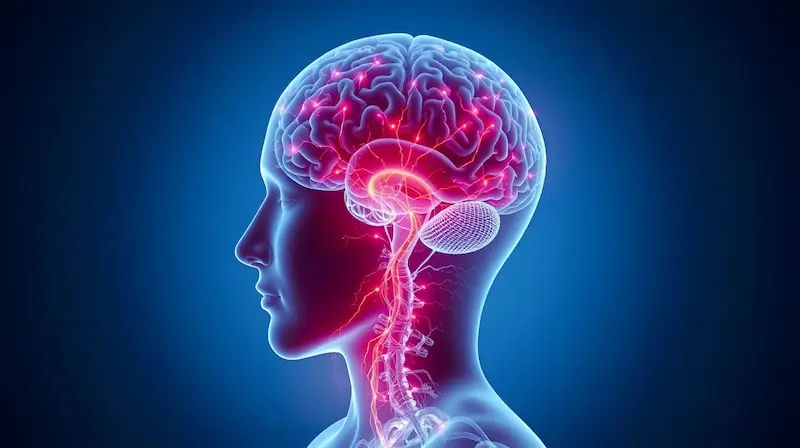What Leads To Signs Of Motor Neurone Disease (MND)?
Learn about the causes, early signs, risk factors, and treatment options for motor neurone disease (MND). Discover diagnosis, supportive care, and living well with MND.

Written by Dr. Dhankecha Mayank Dineshbhai
Reviewed by Dr. Vasanthasree Nair MBBS
Last updated on 28th Oct, 2025

Introduction
Motor neurone disease (MND), also known as amyotrophic lateral sclerosis (ALS), affects the nerve cells that control movement, leading to progressive weakness. For many people, the first hints are subtle: a foot that trips more often, a hand that tires quickly, slurred speech after a long day, or persistent muscle twitching. But what actually leads to these signs—and how can you tell when it’s time to seek help? In this guide, we break down what causes the signs of motor neurone disease in everyday language. You’ll learn how motor neurons work, why symptoms appear where they do, who’s at risk, and what else can look similar but is treatable. We’ll explain the diagnostic process (including EMG and MRI), what to expect over time, and practical steps to live well with MND—from medications like riluzole to breathing and nutrition support. Whether you’re noticing early changes or supporting a loved one, you’ll find evidence-based insights, examples, and helpful next steps. If symptoms persist beyond two weeks or you’re worried about weakness or speech changes, consult a doctor online with Apollo 24|7 for further evaluation and guidance.
MND in simple terms: what it is and how it affects the body
Motor neurone disease is a progressive condition where the nerve cells that send signals from the brain and spinal cord to muscles gradually degenerate. As these upper and lower motor neurons are lost, muscles no longer receive strong, coordinated signals. The result is weakness, muscle wasting, cramps, and changes in reflexes. The most common form of MND is amyotrophic lateral sclerosis (ALS), but clinicians also use related labels depending on which motor neurons are most affected first and which symptoms dominate.
ALS and other motor neurone disease types (PLS, PMA, PBP)
ALS involves both upper motor neuron (UMN) and lower motor neuron (LMN) signs. Primary lateral sclerosis (PLS) mainly affects UMNs, causing stiffness and slow, effortful movement. Progressive muscular atrophy (PMA) mainly involves LMNs, showing more wasting and twitching. Progressive bulbar palsy (PBP) starts with speech and swallowing difficulties. Understanding the subtype helps set expectations and tailor care, though many features overlap.
Consult Top Specialists
Upper vs lower motor neurons: why it matters for symptoms
UMN damage leads to stiffness, brisk reflexes, and slowed movements. LMN damage causes fasciculations (twitching), cramps, and muscle wasting. Most people experience a mix, which is a hallmark of ALS. This combination helps clinicians distinguish MND from other conditions.
What actually leads to the signs of MND? (The “why” behind the symptoms)
Here's why symptoms occur:
The signs of motor neurone disease come directly from failing motor neurons and secondarily from the muscles they control. Several biological processes contribute to the pattern and tempo of symptoms.
How motor neurons break down: protein clumps, oxidative stress, excitotoxicity
Research points to multiple pathways of injury in motor neurons: abnormal protein handling, oxidative stress, mitochondrial dysfunction, and glutamate excitotoxicity. In many familial cases, genetic changes drive these processes. As neurons fail, muscle fibres no longer get robust activation, causing twitching, cramps, and eventually weakness and atrophy.
Why signs appear in different places first (bulbar vs limb onset)
Some people first notice slurred speech or choking (bulbar onset), while others notice tripping, foot drop, or hand clumsiness (limb onset). Where the first signs emerge depends on which motor neuron pools are affected earliest. Over time, symptoms spread to neighbouring regions, reflecting the progressive nature of motor neuron degeneration.
Early signs of motor neurone disease you shouldn’t ignore
Here's what to watch for:
Limb weakness, foot drop, hand clumsiness
Common limb-onset signs include foot scuffing, frequent tripping, difficulty lifting the front of the foot (foot drop), trouble buttoning shirts or turning keys, reduced grip, muscle twitching (fasciculations) in the calves or arms, and cramps that feel different from usual post-exercise cramps.
Bulbar symptoms: speech, swallowing, and saliva changes
Early bulbar signs include slurred or nasal-sounding speech, a “tired voice,” coughing with thin liquids, longer meals due to chewing fatigue, and drooling from reduced lip seal. Persistent signs warrant attention.
Breathing and sleep-related clues
Clues include morning headaches, unrestful sleep, waking short of breath, vivid nightmares, daytime fatigue, and shallow breathing when lying flat. These often indicate weak diaphragm or chest wall muscles and are treatable with non-invasive ventilation.
A short case example to illustrate early detection
Example: A 56-year-old notices right-foot tripping and calf twitching at rest for six weeks. Exam shows foot dorsiflexion weakness and brisk knee reflexes. EMG confirms motor neuron involvement; MRI rules out a spine cause. Early diagnosis enables starting riluzole and physiotherapy while planning workplace adjustments. If symptoms persist beyond two weeks, consult a doctor online with Apollo 24|7 for further evaluation.
Causes and risk factors: who is most at risk?
Here's what increases the likelihood of developing MND:
Genetics: familial MND (SOD1, C9orf72, TARDBP, FUS)
Around 5–10% of MND is familial, often inherited in an autosomal dominant pattern. The most frequent genetic contributors include C9orf72 repeat expansions and mutations in SOD1, TARDBP, and FUS. Genetic counselling helps families understand risks and testing options.
Sporadic MND and environmental factors (age, sex, smoking, military service)
Most cases are sporadic. Risk rises with age (commonly 55–75 years), with a slight male predominance earlier in life. Some studies suggest associations with smoking and prior military service. General health steps, especially smoking cessation, are advisable for overall risk reduction.
MND–FTD overlap: why thinking and behaviour can change
A subset of people develop frontotemporal dementia (FTD) features—changes in behaviour, decision-making, or language—due to shared biology between MND and FTD, particularly with C9orf72 expansions. Recognising this overlap helps families plan and clinicians adapt communication and decision support.
What does not cause MND? Common myths, clarified
Here's what you should know:
Vaccines, minor injuries, and routine meds
Extensive evidence does not support vaccines, minor falls, or common medications as causes of motor neurone disease. Correlation in time does not imply causation.
Exercise: helpful for health, debated in MND risk
Regular physical activity is broadly beneficial. Some studies explore links between high-intensity or elite-level sport and ALS risk, but findings are mixed. Standard exercise remains important for overall health.
How doctors diagnose MND
Here's the diagnostic approach:
The clinical exam: spotting upper and lower motor neuron signs
Doctors look for UMN signs (spasticity, brisk reflexes, Babinski sign) and LMN signs (wasting, fasciculations, reduced reflexes). Patterns across body regions help confirm MND and its type.
Tests that help: EMG/NCS, MRI, blood tests, genetic testing
Electromyography detects denervation and reinnervation patterns; nerve conduction studies help exclude other disorders. MRI rules out structural causes. Blood tests evaluate thyroid, vitamin B12, and other metabolic issues. Genetic testing may be offered in familial cases. Apollo 24|7 offers home collection for screening tests if recommended.
Diagnostic criteria you may hear: El Escorial, Gold Coast
Clinicians may reference these criteria, which emphasise UMN and LMN signs across regions and the exclusion of mimics.
Conditions that mimic MND (and are treatable)
Here's what to check for:
Vitamin B12 issues, thyroid problems, myasthenia gravis
B12 deficiency can cause neuropathy and weakness; hypothyroidism can contribute to cramps and fatigue; myasthenia gravis causes fluctuating weakness and fatigable speech/swallowing. These conditions are often treatable.
Neural and spine causes: CIDP, multifocal motor neuropathy, cervical myelopathy
- CIDP and MMN can mimic LMN weakness and are treatable with immunotherapy. Cervical spondylotic myelopathy can create UMN-style signs in the legs and LMN signs in the arms.
- EMG/NCS and MRI help distinguish these.
When to suspect a mimic: sensory symptoms, fluctuating weakness
Sensory loss, marked numbness, pain, or strongly fluctuating symptoms are less typical of MND and should raise suspicion for an alternative diagnosis. Book a physical visit with Apollo 24|7 if unclear after initial assessments.
How MND progresses and what to expect
Here's what to know about progression:
Staging and function: the ALSFRS-R score
The ALS Functional Rating Scale–Revised tracks daily function in speech, swallowing, walking, and breathing, guiding interventions like ventilation and feeding support.
Prognosis: why it varies by person and MND type
Progression differs; some people live beyond a decade, while the median is often 2–5 years in ALS. Factors include site of onset, rate of decline, respiratory involvement, age, and genetics. PLS generally progresses more slowly than ALS, and PMA varies widely.
Living well with MND: treatments and day-to-day support
Here's how to manage the condition:
Medicines that may slow progression (riluzole; edaravone in select cases)
Riluzole modestly extends survival. Edaravone may benefit selected early-stage patients. Availability and eligibility depend on region.
Breathing and nutrition support: NIV, cough assist, PEG feeding
Non-invasive ventilation improves sleep, energy, and survival. Cough-assist devices help clear secretions. Early nutrition support and timely discussions about feeding tubes maintain weight and reduce aspiration risk.
Physiotherapy, speech therapy, and assistive devices
Physiotherapy preserves mobility; occupational therapy adapts home and work environments; speech therapy supports communication and swallowing. Assistive devices like ankle–foot orthoses or communication aids maintain independence.
Mood, cognition, and FTD screening
Anxiety, low mood, and cognitive or behavioural changes are common and treatable. Screening for FTD features enables tailored support.
Can you prevent MND or reduce risk?
Here's what is known:
Lifestyle steps with broader health benefits
No proven prevention exists. However, quitting smoking, using protective equipment, maintaining fitness, and adequate sleep have general health benefits.
Genetic counselling for familial MND
If multiple relatives are affected, genetic counselling can clarify risks and family planning options. Discuss with your neurologist before any testing.
When to see a doctor—and what to bring
Here's guidance for timely assessment:
Red flags and
- timelines for action
- Seek medical attention for persistent limb weakness, foot drop, hand weakness, frequent tripping, slurred speech, swallowing difficulties, persistent twitching with weakness, or unexplained breathing problems during sleep. If symptoms persist beyond two weeks, consult a doctor online with Apollo 24|7.
Tests that may be ordered and how to prepare
EMG/NCS, MRI, and blood tests (B12, thyroid, CK) may be ordered. Apollo 24|7 offers home collection for recommended tests. Prepare a symptom timeline, medication list, family history, and optionally a short video of walking or speech.
The research horizon: what’s changing
Here's what’s emerging:
Gene-targeted therapies and antisense approaches
Trials explore antisense oligonucleotides for genetic forms like SOD1, aiming to target the root cause in familial MND.
Biomarkers like neurofilament light (NfL)
Blood and spinal fluid markers such as neurofilament light are being studied to detect disease earlier, track progression, and measure drug effects.
Support that makes a difference
Here's how support improves quality of life:
Multidisciplinary clinics and caregiver resources
Specialist clinics coordinate neurology, respiratory, nutrition, therapy, and palliative support. Caregivers benefit from education, respite, and peer support.
Planning ahead: legal and practical steps
Advance care planning, ventilation and feeding preferences, and organising financial and legal documents help maintain control and reduce crises. Home adaptations improve safety.
Conclusion
Understanding what leads to the signs of motor neurone disease starts with knowing how motor neurons work and what happens when they begin to fail. Weakness, cramps, twitching, and speech or swallowing changes reflect gradual loss of upper and lower motor neuron function. While MND is usually not preventable and lacks a cure, early recognition allows treatments that slow progression, ease symptoms, and support independence.
If you’ve noticed new, persistent weakness, foot drop, or changes in speech or swallowing, seek timely assessment so your care team can rule out treatable mimics, arrange EMG and imaging if needed, and start supportive care early. Multidisciplinary approaches—neurology, respiratory support, therapy services, nutrition, and mental health care—make a substantial difference. If symptoms persist beyond two weeks, consult a doctor online with Apollo 24|7. Home collection is available for lab tests like B12 and thyroid profiles.
Research is advancing rapidly, from gene-targeted therapies to biomarkers that may accelerate diagnosis. Meanwhile, riluzole, non-invasive ventilation, speech and swallowing support, assistive devices, and advance care planning help people live well with MND. Support groups and specialist clinics are available at every stage.
Consult Top Specialists
Consult Top Specialists

Dr Debnath Dwaipayan
Neurosurgeon
9 Years • MBBS, MS(Gen. Surgery), DrNB (Neurosurgery)
Delhi
Apollo Hospitals Indraprastha, Delhi

Dr. Dipti Ranjan Tripathy
Neurologist
15 Years • MBBS, MD (GENERAL MEDICINE ),DM (NEUROLOGY)
Rourkela
Apollo Hospitals, Rourkela, Rourkela

Dr. Dipjyoti Payeng
Neurologist
7 Years • "MBBS, MD, DNB (Neurology) "
Guwahati
Apollo Excelcare Hospital, Guwahati
Dr. Sandeep Gurram
Neurologist
12 Years • MBBS, MD(Internal Medicine), DM(Neurology), PDF(Movement disorders) - NIMHANS
Secunderabad
Apollo Hospitals Secunderabad, Secunderabad

Dr. Sathish Kumar V
Neurologist
16 Years • D.M Neurology (PGIMER, Chandigarh), • M.D General Medicine (GSVM Medical College, Kanpur )
Chennai
Apollo Speciality Hospitals OMR, Chennai
(200+ Patients)
Consult Top Specialists

Dr Debnath Dwaipayan
Neurosurgeon
9 Years • MBBS, MS(Gen. Surgery), DrNB (Neurosurgery)
Delhi
Apollo Hospitals Indraprastha, Delhi

Dr. Dipti Ranjan Tripathy
Neurologist
15 Years • MBBS, MD (GENERAL MEDICINE ),DM (NEUROLOGY)
Rourkela
Apollo Hospitals, Rourkela, Rourkela

Dr. Dipjyoti Payeng
Neurologist
7 Years • "MBBS, MD, DNB (Neurology) "
Guwahati
Apollo Excelcare Hospital, Guwahati
Dr. Sandeep Gurram
Neurologist
12 Years • MBBS, MD(Internal Medicine), DM(Neurology), PDF(Movement disorders) - NIMHANS
Secunderabad
Apollo Hospitals Secunderabad, Secunderabad

Dr. Sathish Kumar V
Neurologist
16 Years • D.M Neurology (PGIMER, Chandigarh), • M.D General Medicine (GSVM Medical College, Kanpur )
Chennai
Apollo Speciality Hospitals OMR, Chennai
(200+ Patients)
More articles from Neurological Disorders
Frequently Asked Questions
Is motor neurone disease the same as ALS?
Yes. ALS is the most common type of MND. “MND” is used more in the UK, while “ALS” is common in the US. Both refer to progressive damage to motor neurons.
What are the earliest signs I should look for?
Early signs include foot drop, frequent tripping, hand clumsiness, persistent muscle twitching, and slurred or nasal speech. Seek evaluation early; ask about EMG testing if weakness persists.
Are there treatable conditions that look like MND?
Yes. Vitamin B12 deficiency, thyroid problems, myasthenia gravis, CIDP, and multifocal motor neuropathy can mimic MND symptoms and may be treatable.
What treatments can slow MND?
Riluzole can modestly slow progression. Edaravone may help selected patients. Non-invasive ventilation, nutrition support, and therapies improve quality of life.
When should I see a doctor?
If you have persistent weakness, foot drop, difficulty speaking or swallowing, or unexplained breathlessness lasting more than two weeks, consult a doctor online with Apollo 24|7 or schedule an in-person visit.

